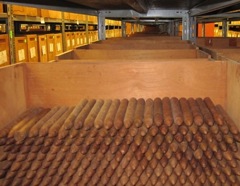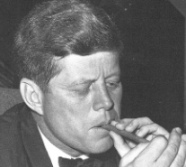Cigar Review: NHC Surrogates Bone Crusher
15 Feb 2012
If you only pick up cigars from your local shop then you probably haven’t heard of the Surrogates Skull Breaker and Bone Crusher cigars. These cigars are only available from New Havana Cigars (NHC), an online-only shop based in Columbus, Ohio.
 Unlike most online retailers, NHC’s selection is limited to a handful of more boutique cigarmakers like Tatuaje, Illusione, Viaje, E.P. Carrillo, and 7-20-4, including many hard to find limited releases. NHC has featured a number of exclusive smokes—including the NHC Selección Limitada (a box-pressed size of the Tatuaje Brown Label) and the My Uzi Weighs a Ton Bait Fish (a corona size of the Drew Estate MUWAT)—but Surrogates is the first truly new brand created by NHC.
Unlike most online retailers, NHC’s selection is limited to a handful of more boutique cigarmakers like Tatuaje, Illusione, Viaje, E.P. Carrillo, and 7-20-4, including many hard to find limited releases. NHC has featured a number of exclusive smokes—including the NHC Selección Limitada (a box-pressed size of the Tatuaje Brown Label) and the My Uzi Weighs a Ton Bait Fish (a corona size of the Drew Estate MUWAT)—but Surrogates is the first truly new brand created by NHC.
Last August, NHC owner Dan Welsh described his thinking about the line this way: “I wanted to create a brand for NHC that would bring new customers and service our loyal customers. Looking at our business over the last four years, it was obvious that our clients demanded something special. One thing that was missing was constant availability… Surrogates was created to solve the problem of choosing whether to save or smoke that special vitola. The answer, is both.”
Beyond saying the cigar is created “utilizing a new source” (implying it isn’t made at any of the factories where the cigars he stocks are produced) Welsh reveals few details about the blend, except that the wrapper is broadleaf and it is “made in Central America.” In its current listing on the site a few more details are revealed, as the description says the cigar’s origin is Nicaragua, as is the wrapper and filler.
Shrouded in a bit of intended mystery, one is left to smoke the cigar and evaluate it on its own terms. Available in two sizes, Skull Breaker is a belicoso that measures 5.25 inches with a ring gauge of 52 and Bone Crusher (the subject of this review) is a parejo that measures 5.25 inches with a ring gauge of 54. The Bone Crusher samples I smoked are clearly well-made. The dark, nearly vein-free wrapper is framed by dual matte black bands. The cigar produces a perfectly even burn and sturdy ash that holds for well over an inch.
Bone Crusher yields heavy smoke with a density that coats the palate. Its extremely full-bodied flavors are dominated by espresso, earth, and leather. There’s a bit of pepper at the start but also some lingering bitterness, especially towards the end. All in all, Bone Crusher seems an appropriate name for this cigar. It’s powerful, flavorful, and one of the most full-bodied cigars available anywhere. But all that power comes with a price, as there’s no subtlety or finesse, and little in the way of balance.
Still, it is a cigar that can be enjoyed under the right circumstances: a full-stomach and a strong drink help. And while it’s a bit too powerful to be a favorite of mine, it’s a cigar I might turn to when I want a true flavor bomb. At $7.50 each and $120 for a box of 20, it’s worth a try if you’re a fan of strong cigars. So even though it lacks finesse, the NHC Surrogates Bone Crusher earns a favorable rating of three and a half stogies out of five.

[To read more StogieGuys.com cigar reviews, please click here.]
photo credit: Stogie Guys

 The seven-size line is part of the Ashton portfolio and one of three La Aroma de Cuba blends mentioned on the Ashton
The seven-size line is part of the Ashton portfolio and one of three La Aroma de Cuba blends mentioned on the Ashton  Tobacco is organic matter, which means that chemically it will change with time. During a cigar’s life, the tobacco changes, and that impacts the flavor. Today I’m breaking down aging into three basic categories:
Tobacco is organic matter, which means that chemically it will change with time. During a cigar’s life, the tobacco changes, and that impacts the flavor. Today I’m breaking down aging into three basic categories:

 1) The U.S. embargo against Cuba turned
1) The U.S. embargo against Cuba turned  In theory at least, it makes plenty of sense. Cigar factories are always trimming tobacco leaves down to the sizes they need for their premium offerings. If instead of being tossed, those trimmings are used in mixed-filler cigars, the price of the raw materials goes down even though the quality of tobacco is the same as a cigar many times the price.
In theory at least, it makes plenty of sense. Cigar factories are always trimming tobacco leaves down to the sizes they need for their premium offerings. If instead of being tossed, those trimmings are used in mixed-filler cigars, the price of the raw materials goes down even though the quality of tobacco is the same as a cigar many times the price.
 Patrick Ashby
Co-Founder & Editor in Chief
Patrick Ashby
Co-Founder & Editor in Chief Patrick Semmens
Co-Founder & Publisher
Patrick Semmens
Co-Founder & Publisher George Edmonson
Tampa Bureau Chief
George Edmonson
Tampa Bureau Chief